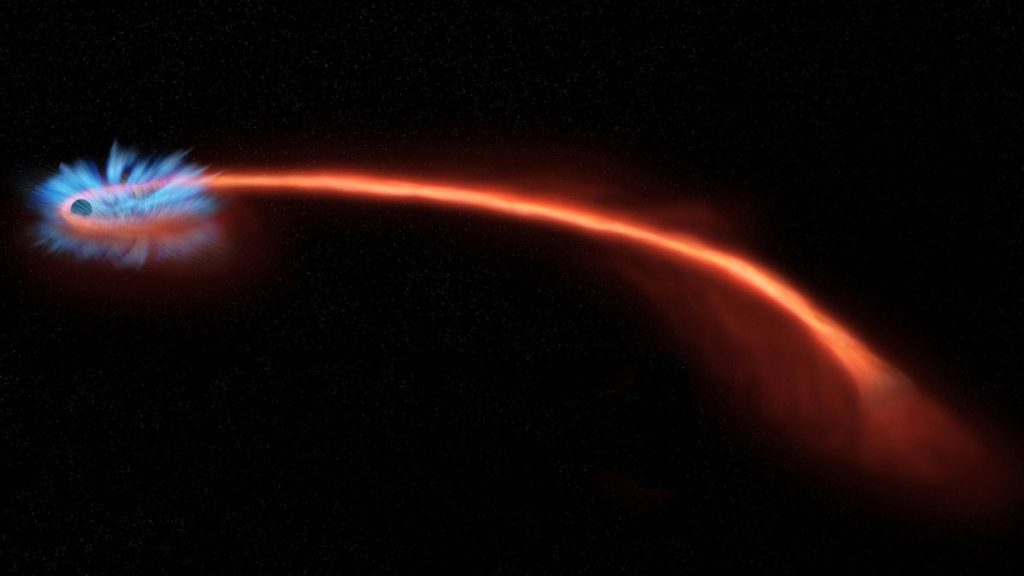A cosmic crime scene has revealed the gory details of black holes’ eating habits.
In a new study, astronomers studied a supermassive black hole‘s destruction of a star, revealing how these cosmic titans consume the material from objects that venture too close to them. The research shows that a significant amount of this material is blown away from, rather than being consumed by, the black hole.
The grisly act, which happened 215 million light-years from Earth, was first observed in October 2019 and represents the aftermath of a sunlike star being destroyed by a black hole over 1 million times its mass. This was the nearest example of a stellar body being “spaghettified” by the massive tidal forces generated by a black hole that astronomers have ever spotted.
Related: Black hole kills star by ‘spaghettification’ as telescopes watch
This so-called tidal disruption event (TDE) occurred in a spiral galaxy in the constellation Eridanus. It was the first event of this type to be bright enough in visible light to allow astronomers to study the details of what happens to material from the star after it is shredded.
By observing the polarization of light from the event, researchers at the University of California, Berkeley, deduced that much of this stellar material was blasted away from the black hole at speeds as great as 22 million mph (35 million kph).
This blast , named AT2019qiz, created a cloud of gas that these new observations of polarized light reveal is spherically symmetrical. This gas cloud is as wide as 200 times the average distance from Earth to the sun. This means its radius is 100 times larger than our planet’s orbit, and its outer edge is about 930 million miles (1.5 billion kilometers) from the central black hole.
“One of the craziest things a supermassive black hole can do is to shred a star by its enormous tidal forces,” Wenbin Lu, an astronomer at UC Berkeley and co-author of a new paper describing the observations, said in a statement (opens in new tab). “These stellar tidal disruption events are one of the very few ways astronomers know the existence of supermassive black holes at the centers of galaxies and measure their properties. However, due to the extreme computational cost in numerically simulating such events, astronomers still do not understand the complicated processes after a tidal disruption.”
The new findings could explain why astronomers don’t see high-energy emissions, like X-rays, from other TDEs. Such emissions are created as material from the star is dragged into a thin disk around the black hole. This material is heated in the disc creating high-energy emissions which also result when the material falls into the black hole. These emissions are obscured by these gas clouds blown out by powerful winds.
“This observation rules out a class of solutions that have been proposed theoretically and gives us a stronger constraint on what happens to gas around a black hole,” Kishore Patra, a graduate student in astronomy at UC Berkeley and lead author of the paper, said in the statement (opens in new tab). “People have been seeing other evidence of wind coming out of these events, and I think this polarization study definitely makes that evidence stronger, in the sense that you wouldn’t get a spherical geometry without having a sufficient amount of wind.
“The interesting fact here is that a significant fraction of the material in the star that is spiraling inward doesn’t eventually fall into the black hole ; it’s blown away from the black hole,” Patra added.
The results seem to contradict a theory proposed by many astronomers: that when a star is destroyed by a black hole, a highly asymmetrical accretion disk forms. Such a disk would demonstrate a high degree of polarized light — something not seen in this TDE.
The second set of observations from this event in November 2019 showed that the light from it was only slightly polarized. This finding suggested that the gas cloud of ejected material had thinned enough to reveal the asymmetrical gas structure around the black hole, the team said.
“The accretion disk itself is hot enough to emit most of its light in X-rays, but that light has to come through this cloud, and there are many scatterings, absorptions, and reemissions of light before it can escape out of this cloud,” Patra said. “With each of these processes, the light loses some of its photon energy, going all the way down to ultraviolet and optical energies. The final scatter then determines the polarization state of the photon. So, by measuring polarization, we can deduce the geometry of the surface where the final scatter happens.”
Petra added that the “deathbed scenario” the team observed for this star may not apply to “oddball” TDEs in which jets of material are ejected at near light speed only from the poles of the black hole. To answer this question, further polarization studies of TDEs will be needed.
“Polarization studies are very challenging, and very few people are well-versed enough in the technique around the world to utilize this,” Petra said. “So, this is uncharted territory for tidal disruption events.”
Both sets of observations were made using the 3-meter (10 feet) Shane telescope at the Lick Observatory near San Jose, California. The telescope is fitted with the Kast spectrograph, an instrument that can determine the polarization of light over the full optical spectrum.
The team’s paper will be published in September’s issue of the journal Monthly Notices of the Royal Astronomical Society (opens in new tab).
Follow us on Twitter @Spacedotcom and on Facebook.

